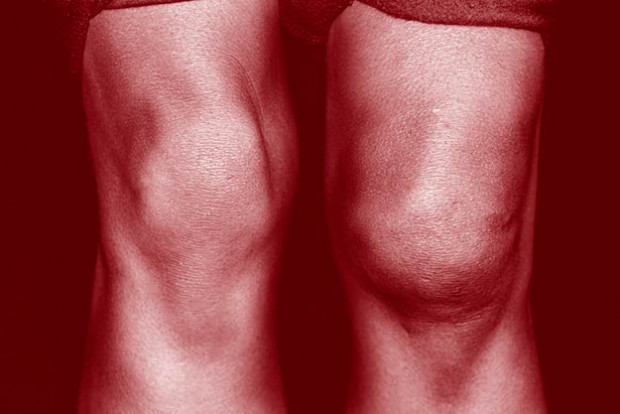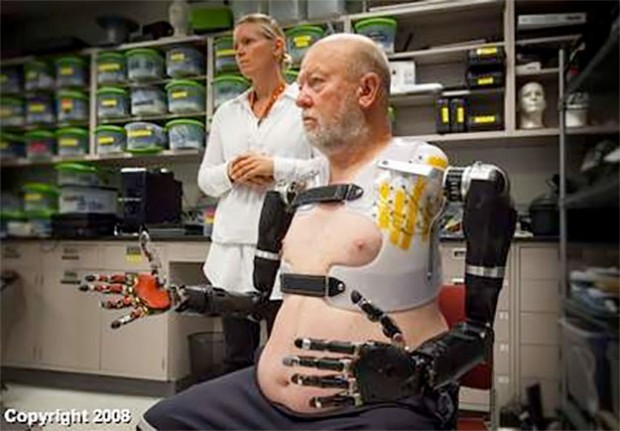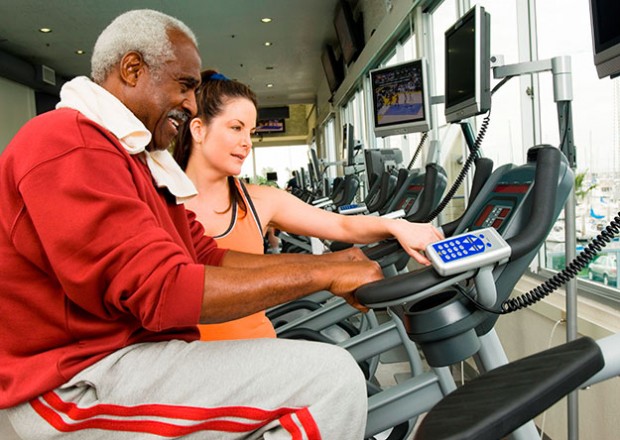Kauai Physical Therapy Blog
Home of Action Physical Therapy: Kauai's Premier Physical Therapy and Personal Fitness Clinic
Rehabilitation
A New Therapy Instrument is Revolutionizing Stroke Rehab
Power Chord
At Action Physical Therapy, we all have our own opinions about who is making the best music these days. With flood of new artists pouring onto the scene, it’s hard to keep up. But something that we all agree on, is how powerful music can be in the recovery process. For decades, music therapy has been employed in rehabilitation programs and lauded for its positive impact.
Historically, music therapy has been in the form songs played or performed for the patient. But a recent advancement is changing the tune of music therapy, by putting it directly in the patient’s hands.
Flint Rehabilitation Devices has introduced a revolutionary tool in stroke rehabilitation with their MusicGlove, a computing device worn over the hand to help improve fine motor skills that have been compromised due to a stroke.
Combined with a specially fitted mobile tablet device, MusicGlove users play a Guitar-hero style game that can help them restore movement in their fingers and hands. In stroke therapy, massive repetition of movement to the affected parts of the body is proven to help the brain re-route neuronal circuits. This allows the patient to regain at least some (and sometimes all) of their motor function.
The problem with repetition is that it’s, well, repetitive and gets boring for the patient. Imagine repeating the same hand motion 1,000 times, every day for weeks or months at a time. When the patient’s therapy sessions have ended, and they are left to perform these exercises at home, compliance falls drastically. The MusicGlove is designed to make these repetitive (yet crucial) hand exercises fun and engaging.
The proof is in MusicGlove’s research, which has shown greater improvement in regaining motion when compared to conventional rehab exercises. And, patients stay more compliant with their at-home therapy.
Perhaps the best part of MusicGlove is its access. It has a relatively cheap price tag (at least when compared to other rehab medical devices), is completely portable, very easy to set up and use, and doesn’t require a doctor’s prescription. In fact, it’s even available on Amazon.
The MusicGlove’s versatility goes well beyond stroke therapy. Patients with brain, spinal cord, muscular, and other forms of neurological injury can also benefit from this exciting new technology. And that is music to our ears.
MMA Training Tradition Comes Under Scrutiny With Injured Champ
Old School Vs. New Class
 In a press conference this morning, the often outspoken UFC President Dana White scrutinized training techniques that he asserts led to a champ’s career-threatening MCL tear. White charges that American Kickboxing Academy (AKA)— training facility of current UFC Heavy Weight Champion Cain Velasquez—is “still in the stone ages” when it comes to their fight prep regimen.
In a press conference this morning, the often outspoken UFC President Dana White scrutinized training techniques that he asserts led to a champ’s career-threatening MCL tear. White charges that American Kickboxing Academy (AKA)— training facility of current UFC Heavy Weight Champion Cain Velasquez—is “still in the stone ages” when it comes to their fight prep regimen.
Cain Velasquez has a string of injuries that have kept him out of title bouts with eager challengers. He last fought in 2013, when he dethroned former heavy weight champ Junior dos Santos at UFC 166, but has since been sidelined by training-induced shoulder and knee injuries.
White has become so frustrated by injuries sustained in training (and the events that don’t happen because of them) he announced that UFC’s new headquarters in Las Vegas will include a “huge facility for rehab and therapy” that will focus on “educating the fighters on training better.”
It’s important to note that Velasquez, whose professional record is 14 and 1 (his latest win in the form of a championship belt), is obviously doing something right. In fact, AKA is home to number of top MMA contenders. And, while other fighters, trainers, and sideline commentators will surely contest White’s words, he does bring to light the importance of aligning injury prevention and fight preparation.
The details of UFC’s new HQ have yet to be divulged and the initial announcement leaves much to the imagination. But, it will be interesting to see if White’s vision for a bigger, better training compound will reduce injuries and still produce champions. In the meantime, we hope Cain Velasquez recovers well and look forward to seeing him back in action again soon.
If you’d like to include injury prevention in your training program, or need therapy from an injury that’s already happened, we’re here to help. Some of our own patients are making a living in the octagon, so we have an intimate understanding of what kinds of injuries occur and how to help them heal.
Waves of Consequence
Large Australian Swells Testing Competitive Limits

SIx Times World Surfing Champion, Stephanie Gilmore, in a better place. Photo courtesy of Stephanie Gilmore’s Facebook page.
On a recent free surf in Australia, six-time world champ Stephanie Gilmore wiped out with bone-breaking intensity. “I fractured my fibula… I just ejected out of the lip, tried to pin drop feet-first and went straight-legged into the sand,” said Gilmore in an interview during the 2015 Drug Aware Margaret River Pro. It not only kept her from competing in the contest, it also highlights the range of injuries that can be sustained while surfing.
We see a lot of strains, sprains, and tears in our patients at Action Physical Therapy— especially the ones that surf—but fractures are less common. Which is actually a little surprising, considering a cubic meter of water (about the size of your oven) weighs a ton. The eight- to twelve-foot waves breaking at the 2015 Margaret River Pro were unleashing hundreds of tons of water at the competitors riding them. The athleticism and flexibility of even the most prepared, intensely trained surfers are tested when they met the wrong side of those breaking waves. (Ninth best surfer in the world, Jordy Smith, had to pull out of the competition because of injuries sustained to his foot and knee during a between-round surf at spot near Margaret River.)
And, while it may sound more serious, a fracture can be more preferable to something like a ligament tear. A hairline fracture like the one Stephanie Gilmore sustained, often does not require surgery, but will need rest and physical therapy to ensure it heals correctly and completely.
If you’re experiencing pain while surfing, or any other activity for that matter, it could be an undiagnosed, yet easily treatable issue. We encourage you to talk to your doctor, or call us for a consult. We can create a specialized PT program for surfing injuries, and the many other conditions that go with living an active life.
We wish Stephanie Gilmore the best in her recovery, and look forward to watching her rip in the upcoming Oi Rio Women’s Pro in Brazil. And congrats to John John Florence on his runner up win at the Margie’s Men’s Pro! He walked away with second place, but he’s a first-rate competitor and ambassador for Hawaii. #GoJohnJohnGo!
Physical Therapy Comes Home
New Study Shows In-home PT Just as Effective as In-patient
 For knee replacement patients itching to get back home quickly, new research is providing a great prognosis: people who choose at-home physical therapy instead of in-patient rehabilitation after knee replacement surgery do just as well when it comes to complications, long-term pain management and movement recovery.
For knee replacement patients itching to get back home quickly, new research is providing a great prognosis: people who choose at-home physical therapy instead of in-patient rehabilitation after knee replacement surgery do just as well when it comes to complications, long-term pain management and movement recovery.
The study was inspired by a growing number of knee surgery patients being sent directly home from the hospital, instead of to a rehab center—a trend being partly driven by the growing hesitation of insurance companies and Medicare to cover the cost of in-patient rehab.
Of the 2,400-knee replacement patients studied, there was no difference observed between the in-patient and at-home groups at the six-month post-surgery mark in terms of infection risk, knee stiffness or other complications. Nor were differences observed after two years in terms of progress made, pain experienced or ability to move. Moreover, a previous study in 2008 revealed a nearly 30 percent drop in medical costs between at-home and in-patient rehabilitation care.
This isn’t to say that a patient should automatically be sent home for rehab. His or her strength, frailty, and overall medical condition (among other factors) may require in-patient care. While this research is an eye opening first step in the merits of in-home rehabilitation, it will take more time to understand which patients will benefit most from care at home or in hospital facilities.
Read more about this study and our Home Exercise Program services.
Greenback Therapy; Starting with PT for Back Pain Equals Bigger Cost Savings
When new patients suffering lower back pain begin their treatment with physical therapy, they spend less and accrue fewer medical costs associated with their condition. Those are the findings posted in a recent study in the scientific journal Health Services Research.
 Researchers found that patients who were referred to physical therapy compared to those who were referred for MRI (Magnet Resonance Imaging) for lower back pain paid almost a third of the costs. Initial referral for physical therapy cost $504 on average (for an average 3.8 visits), compared with an average of $1,306 for MRI. Subsequent costs over the next year also came in less—nearly 72% lower for patients who began with a physical therapy referral.
Researchers found that patients who were referred to physical therapy compared to those who were referred for MRI (Magnet Resonance Imaging) for lower back pain paid almost a third of the costs. Initial referral for physical therapy cost $504 on average (for an average 3.8 visits), compared with an average of $1,306 for MRI. Subsequent costs over the next year also came in less—nearly 72% lower for patients who began with a physical therapy referral.
The study also discovered that patients who receive imaging as a first referral increased the likelihood of surgery and injections as well as specialist and emergency department visits within a year. “This is one of many studies demonstrating that physical therapy is a cost-effective alternative to medication and surgery,” said American Physical Therapy Association President Paul Rockar Jr, PT, DPT, MS. “Patients benefit from an active approach to their care and, in turn, society is transformed through the benefits from reduced financial burdens on our health care system.”
ACL Injury Prevention: Crucial New Research Could Keep More Players in the Game
It’s an agonizing, yet all too common scene on Monday Night (or Monday afternoon, if you live in Hawaii): a wide receiver, crumpled on the turf, clutching his knee, writhing in pain. Injury to the ACL, or Anterior Cruciate Ligament, is one of the most common sidelining injuries for professional football players.
 According to a recent article in Medscape, the main reason is not high-impact collisions as many originally thought, but something far less conspicuous – body position. “Players in the NFL are tearing their ACLs with movements that were identified as risk factors in female soccer and basketball players in the 1990s”, said Bert Mandelbaum, MD, an orthopedic sports doctor who helped design an injury-prevention program for the Fédération Internationale de Football Association (FIFA).
According to a recent article in Medscape, the main reason is not high-impact collisions as many originally thought, but something far less conspicuous – body position. “Players in the NFL are tearing their ACLs with movements that were identified as risk factors in female soccer and basketball players in the 1990s”, said Bert Mandelbaum, MD, an orthopedic sports doctor who helped design an injury-prevention program for the Fédération Internationale de Football Association (FIFA).
Dr. Mandelbaum and his colleagues analyzed 27 ACL injuries that occurred during the 2013/14 NFL season, and found that two-thirds happened without contact between players. The players were mostly near the line of scrimmage and were injured while planting or cutting to change direction. Much like the injuries he saw in soccer in basketball players, a combination of valgus leg position (when the knee bows inward) and muscle exertion was the primary culprit.
While it’s still early in the research process, we’re excited to see what comes of this study, and if NFL teams will adjust their injury prevention techniques. Early support is already growing. Matthew Matava, MD, team physician for the St. Louis Rams and past president of the NFL Physicians Society, has signed on to help with the study.
Amputee controls two prosthetic limbs by thinking. Wait, what?
Les Baugh was able to use prosthetic arms by simply thinking about it.
 A Colorado man became the first bilateral shoulder-level amputee to wear and simultaneously control two of the Johns Hopkins University Applied Physics Laboratory Modular Prosthetic Limbs (MPL). Les Baugh was able to operate the system by simply thinking about moving his limbs.
A Colorado man became the first bilateral shoulder-level amputee to wear and simultaneously control two of the Johns Hopkins University Applied Physics Laboratory Modular Prosthetic Limbs (MPL). Les Baugh was able to operate the system by simply thinking about moving his limbs.
Before testing the limb system, Baugh underwent a surgery known as targeted muscle reinnervation. “It’s a relatively new surgical procedure that reassigns nerves that once controlled the arm and the hand,” John Hopkins trauma surgeon Albert Chi, MD, said in a release.
Then Baugh was fitted for a custom socket that supports the prosthetic limbs and also makes the neurological connections. By the time the socket was finished, Baugh said he was more than ready to get started. When he was fitted with the socket and the prosthetic limbs were attached, he moved several objects, including an empty cup from a counter-shelf height to a higher shelf, a task that required him to coordinate the control of eight separate motions.
“What really was amazing – and was another major milestone with MPL control – was his ability to control a combination of motions across both arms at the same time. This was a first for simultaneous bimanual control,” said prosthetist Courtney Moran, MS, CP.
Motorized Stationary Bike May Help With Stroke Rehabilitation
It seems that exercising on a motorized stationary bike may help boost stroke patients’ brain and motor skills recovery.
 The study included 17 stroke survivors, all who took part in repetitive task therapy, such as relearning how to hold a cup or fork, or how to dress themselves.
The study included 17 stroke survivors, all who took part in repetitive task therapy, such as relearning how to hold a cup or fork, or how to dress themselves.
All patients did 24 exercise sessions over eight weeks. At the end of that time, the patients who used a motorized stationary bike showed a 34 percent improvement in motor skills, compared with a 16-17 percent improvement in the non-motorized stationary bike users.
Earlier research has shown that aerobic exercise helps the brain learn new information, and that forced exercise on a motorized stationary bike benefits Parkinson’s disease patients. Additionally, aerobic exercise may help enhance the brain’s ability to reorganize itself and form new connections, the study authors said.
The motorized stationary bike helped patients with limited mobility to pedal and achieve and maintain the intensity of training believed necessary to affect brain function, the researchers noted.
“Not only are we improving motor recovery with half the amount of task practice but we’re also improving cardiovascular health, and stroke patients often have cardiovascular (problems),” study author Susan Linder, a physical therapist at the Cleveland Clinic, said in a stroke association news release.
“If we can improve motor recovery and cardiovascular health simultaneously, patients can regain lost motor function and improve their quality of life.”
10 Ways to Increase Insulin Sensitivity for Better Fat Loss

If you impair your body’s ability to efficiently store glucose, and you’ll be fighting an uphill battle against fat loss. You see, insulin sensitivity and glucose metabolism are directly correlated to your body composition. So with that being said, here are 10 ways you can increase insulin sensitivity and make it easier to change your body composition for the better. Here’s to a better, fitter you in 2015.
- Eat Low-Glycemic Carbohydrates
- Make Exercise Part of Your Lifestyle
- Drink Green Tea
- Eat Your Omega 3 Fatty Acids
- Increase Your Fiber Intake
- Avoid Trans Fat
- Cinnamon (Yup, cinnamon)
- Limit Fructose Consumption
- Avoid Fast Food (duh!)
- Get Your Vitamin E
To read the specifics and details of each suggestion click here to visit coachcalorie.com.
Bionic Eyes & the Top 10 Medical Breakthroughs of 2014
 Here are 10 breakthroughs set to reshape healthcare in the coming year. The Cleveland Clinic asked 100 of its top experts — people who focus on patient care very day — to offer insight these are their answers, the top 10 innovations for 2014:
Here are 10 breakthroughs set to reshape healthcare in the coming year. The Cleveland Clinic asked 100 of its top experts — people who focus on patient care very day — to offer insight these are their answers, the top 10 innovations for 2014:
10. Targeted therapy for cancer
9. Heart risk through the gut
8. Personal sedation station
7. Hope for acute heart failure
6. Fecal transplant restores balance
5. Decision support for smarter surgery
4. Breakthrough for hepatitis C
3. Device disrupts seizures
2. Genomic tests for managing cancer
1. The bionic eye becomes reality
Some of these items are more interesting than others. You may not care about fecal transplants, but who doesn’t want a bionic eye? Click here to read more.


